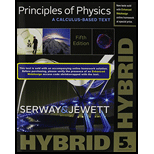
(a)
The intensity of light on the absorbing plate.
(a)
Answer to Problem 67P
The intensity of light on the absorbing plate is
Explanation of Solution
Given info: The diameter of the circular mirror is
The formula to calculate the power is,
Here,
Substitute
The formula to calculate the intensity on plate is,
Here,
Substitute
Conclusion:
Therefore, the intensity of light on the absorbing plate is
(b)
The maximum magnitude of the electric field.
(b)
Answer to Problem 67P
The maximum magnitude of the electric field is
Explanation of Solution
Given info: The diameter of the circular mirror is
The formula to calculate the intensity is,
Here,
Rewrite the equation (2) to find the value of
Substitute
Thus, the maximum magnitude of the electric field is
Conclusion:
Therefore, the maximum magnitude of the electric field is
(c)
The maximum magnitude of the magnetic field.
(c)
Answer to Problem 67P
The maximum magnitude of the electric field is
Explanation of Solution
Given info: The diameter of the circular mirror is
The expression for the magnetic field is,
Here,
Substitute
Conclusion:
Therefore, the maximum magnitude of the electric field is
(d)
The time interval to bring the water to its boiling point.
(d)
Answer to Problem 67P
The time interval to bring the water to its boiling point is
Explanation of Solution
Given info: The diameter of the circular mirror is
The formula to calculate the power consumed in phase change is,
Here,
The formula to calculate the mass is,
Here,
Substitute
The value of the power consumed in heating is,
Substitute
Substitute
Thus, the time interval to bring the water to its boiling point is
Conclusion:
Therefore, the time interval to bring the water to its boiling point is
Want to see more full solutions like this?
Chapter 24 Solutions
Principles of Physics: A Calculus-Based Text, Hybrid (with Enhanced WebAssign Printed Access Card)
- A man slides two boxes up a slope. The two boxes A and B have a mass of 75 kg and 50 kg, respectively. (a) Draw the free body diagram (FBD) of the two crates. (b) Determine the tension in the cable that the man must exert to cause imminent movement from rest of the two boxes. Static friction coefficient USA = 0.25 HSB = 0.35 Kinetic friction coefficient HkA = 0.20 HkB = 0.25 M₁ = 75 kg MB = 50 kg P 35° Figure 3 B 200arrow_forwardA golf ball is struck with a velocity of 20 m/s at point A as shown below (Figure 4). (a) Determine the distance "d" and the time of flight from A to B; (b) Determine the magnitude and the direction of the speed at which the ball strikes the ground at B. 10° V₁ = 20m/s 35º Figure 4 d Barrow_forwardThe rectangular loop of wire shown in the figure (Figure 1) has a mass of 0.18 g per centimeter of length and is pivoted about side ab on a frictionless axis. The current in the wire is 8.5 A in the direction shown. Find the magnitude of the magnetic field parallel to the y-axis that will cause the loop to swing up until its plane makes an angle of 30.0 ∘ with the yz-plane. Find the direction of the magnetic field parallel to the y-axis that will cause the loop to swing up until its plane makes an angle of 30.0 ∘ with the yz-plane.arrow_forward
- A particle with a charge of − 5.20 nC is moving in a uniform magnetic field of (B→=−( 1.22 T )k^. The magnetic force on the particle is measured to be (F→=−( 3.50×10−7 N )i^+( 7.60×10−7 N )j^. Calculate the y and z component of the velocity of the particle.arrow_forwardneed answer asap please thank youarrow_forward3. a. Determine the potential difference between points A and B. b. Why does point A have a higher potential energy? Q = +1.0 C 3.2 cm 4.8 cm Aarrow_forward
 Physics for Scientists and Engineers: Foundations...PhysicsISBN:9781133939146Author:Katz, Debora M.Publisher:Cengage Learning
Physics for Scientists and Engineers: Foundations...PhysicsISBN:9781133939146Author:Katz, Debora M.Publisher:Cengage Learning Principles of Physics: A Calculus-Based TextPhysicsISBN:9781133104261Author:Raymond A. Serway, John W. JewettPublisher:Cengage Learning
Principles of Physics: A Calculus-Based TextPhysicsISBN:9781133104261Author:Raymond A. Serway, John W. JewettPublisher:Cengage Learning
 Physics for Scientists and Engineers, Technology ...PhysicsISBN:9781305116399Author:Raymond A. Serway, John W. JewettPublisher:Cengage Learning
Physics for Scientists and Engineers, Technology ...PhysicsISBN:9781305116399Author:Raymond A. Serway, John W. JewettPublisher:Cengage Learning Physics for Scientists and EngineersPhysicsISBN:9781337553278Author:Raymond A. Serway, John W. JewettPublisher:Cengage Learning
Physics for Scientists and EngineersPhysicsISBN:9781337553278Author:Raymond A. Serway, John W. JewettPublisher:Cengage Learning Physics for Scientists and Engineers with Modern ...PhysicsISBN:9781337553292Author:Raymond A. Serway, John W. JewettPublisher:Cengage Learning
Physics for Scientists and Engineers with Modern ...PhysicsISBN:9781337553292Author:Raymond A. Serway, John W. JewettPublisher:Cengage Learning





